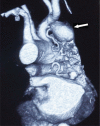Endovascular treatment of ectopic bronchial artery aneurysm with brachiocephalic artery stent placement and coil embolization: A case report and literature review
- PMID: 27583854
- PMCID: PMC5008538
- DOI: 10.1097/MD.0000000000004461
Endovascular treatment of ectopic bronchial artery aneurysm with brachiocephalic artery stent placement and coil embolization: A case report and literature review
Abstract
Background: Bronchial artery aneurysm (BAA) is an uncommon but potentially life-threatening disease, and multiple BAAs are even rarer. Clinically, the tortuous and short neck of a BAA may present significant challenges for invasive intervention.
Methods: This report describes the detailed process of diagnosis and treatment and includes a literature review of the etiology, clinical presentation, and therapeutic management of BAA.
Results: A rare case of multiple BAAs, with one having an inflow artery arising from the brachiocephalic trunk, was referred to our hospital. The patient was successfully treated with coil embolization and brachiocephalic artery stent placement. In addition, we conducted a literature review involving 63 cases of BAA. BAA was most commonly associated with bronchiectasis and was located predominantly in the mediastinum. There was no significant difference between the diameters of the ruptured aneurysms and those of the nonruptured aneurysms (P = 0.115). Transcatheter arterial embolization was the most commonly adopted technique to treat BAA, while thoracic aortic endovascular repair was selected if the neck between the aneurysm and the aorta was short. Subgroup analysis suggested that patients with > 1 BAA were significantly more likely to be female than male (χ test, P = 0.034).
Conclusion: Transcatheter coil embolization combined with stent placement could be a reasonable treatment option for BAAs with a tortuous and short neck. According to our literature review, patients with multiple BAAs display distinctive clinical characteristics compared with patients with a single BAA.
Conflict of interest statement
The authors report no conflicts of interest.
Figures






References
-
- Fujita J, Akashi K, Kunikane H, et al. A case of bronchial artery aneurysm demonstrating a mass shadow on chest X-ray film. Nihon Kyobu Shikkan Gakkai Zasshi 1991; 29:1591–1595. - PubMed
-
- Lu PH, Wang LF, Su YS, et al. Endovascular therapy of bronchial artery aneurysm: five cases with six aneurysms. Cardiovasc Intervent Radiol 2011; 34:508–512. - PubMed
-
- Watanabe H, Numata T, Yanai H, et al. Bronchial artery aneurysm diagnosed on 3D-CT. Intern Med 2014; 53:1451–1452. - PubMed
-
- Sanchez E, Alados P, Zurera L, et al. Bronchial artery aneurysm treated with aortic stent graft and fibrin sealant. Ann Thorac Surg 2007; 83:693–695. - PubMed
-
- Yanagihara K, Ueno Y, Kobayashi T, et al. Bronchial artery aneurysm. Ann Thorac Surg 1999; 67:854–855. - PubMed
Publication types
MeSH terms
LinkOut - more resources
Full Text Sources
Other Literature Sources
Medical

